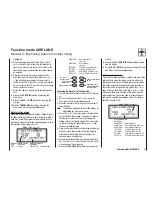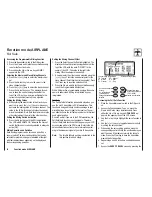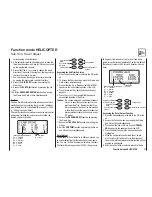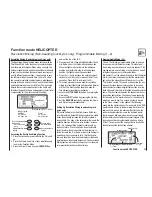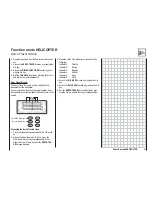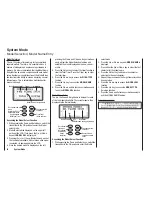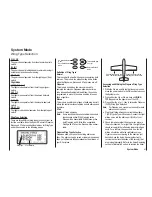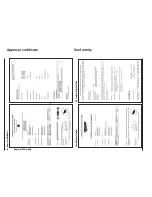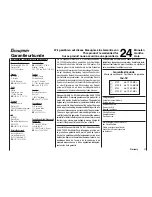
Function mode HELICOPTER
Revolution Mixing (Non-heading lock Gyros only), Programmable Mixing (1~2)
Function mode HELICOPTER
33
Revolution Mixing (Non-heading lock Gyros only)
The Revolution Mixing function mixes tail rotor with the
Throttle and Pitch Curve functions to counteract torque
from the main rotor blades. When set up correctly, the
helicopter should climb and descend without a tendency
to yaw in either direction. Because torque reaction vari-
es with different power settings, it is necessary to vary
the tail rotor pitch at the same time. The mx-12 offers
two separate revolution mixing programs, with indepen-
dent up and down mixing for each - one for Flight mode
position Normal and the other for Stunt. The up mixing
adjusts the tail rotor compensation for the mid to high
throttle setting and the down mixing adjusts the tail rotor
compensation for the mid to low throttle setting.
Mixing Value (L125%~0~R125%)
Mixing Program
NORMAL
STUNT
UP: Up side
UP: Up side
DN: Down side
DN: Down side
Go to Programmable
Mixing menu
Go to Pitch curve
menu
Highlight function to
change
Change value/
Switch selection
Reset selection to
default
Accessing the Revolution Mixing Function
1. Place the transmitter power switch in the ON positi-
on.
2. Press the
Down
and
Select
keys simultaneously
to enter the Function Mode.
3. Press the
Up
or
Down
keys until
REVO MX
ap-
pears at the top of the LCD.
4. Pressing the
Select
key will highlight either the Up
mix, Down mix, or the flight mode switch position.
When the flight mode switch is in the displayed
position and the throttle stick is in the displayed
position, the flight mode will be underlined.
5. Press the (+) key to increase the right tail compen-
sation or press the (-) key to increase the left com-
pensation. Press the
Clear
to reset to 0%.
6. This setup procedure can be used for revolution
mixing for either flight mode switch position Normal
or Stunt. The Stunt position should be used for
forward and/or inverted compensation.
7. Access the
PITCH CURVE
function by pressing the
Down
key.
8. Access the
MX1
function by pressing the
Up
key.
9. Exit the
REVO MX
function by pressing the
Down
and
Select
keys simultaneously.
Setting Up Revolution Mixing (non-heading lock,
gyros only)
Set up the helicopter so that it will hover with the tail
rotor trim entered. Establish the helicopter into a stable
hover, then steadily increase the throttle to initiate a
steady climb. The body of the helicopter will move in the
opposite direction to the main rotor rotation. Increase
the U, Up, setting until the helicopter climbs with no
tendency to turn. At a safe altitude, close the throttle;
the helicopter will same direction as the main rotor ro-
tation. Increase the D, or Down, mix until the helicopter
descends with no tendency to turn. Throttle stick mo-
vements should be slow, and the initial accerlation and
deceleration swings should be ignored. The Accerlation
Mixing function is provided to compensate for the main
rotor accerlation (and decerlation) torque.
Programmable Mixing (1~2)
The mx-12 offers two programmable mixes to be used
for any number of different purposes. This function al-
lows mixing any one channel to any other channel. This
mix can remain on at all times or be switched on and off
in flight using a number or different switches.
Mix number 1 is of the standard variety, in that the digital
trim for the master channel only affect the master chan-
nel, and not the slave channel. Mix number 2 is of the
“Trim include“ variety. This mix is used any time the mix
requires the slave channels trim position to be varied
when the master channels digital trim position is varied.
Each channel of this radio is identified by an abbreviated
name. The chart below indicates the channel ant its cor-
responding abbreviation. The channel name appearing
first is known as the “master channel“ or the channel to
which you want to mix. The second number is known
as the “slave channel“ or the channel that is beeing
mixed into the master-channel. For example, AIL
RUD
would indicate aileron-to-rudder mixing. Each time the
aileron stick is moved, the aileron will deflect, and the
rudder will automatically move in the direction and to
the value input. Mixing is proportional, so small inputs
of the master channel will produce small outputs of the
slave channel. Each programmable mix has a mixing
“offset“. The purpose of the mixing offset is to redefine
the neutral position of the slave channel.
Mix SW selection
Mix percentages
(+/- 125%)
Master Channel
Slave Channel
Offset value
(+/- 125)



